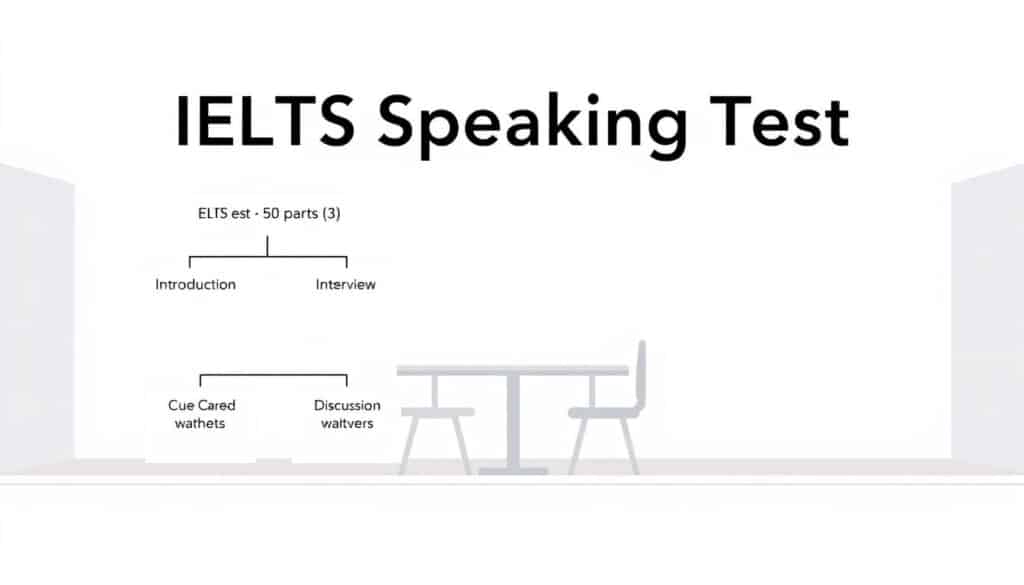Welcome to your ultimate guide to excelling in the IELTS Speaking test! This section will walk you through the test structure, timing, expert tips, and essential strategies to help you achieve a high score. The IELTS Speaking test is a face-to-face interview that lasts between 10 to 15 minutes. It is divided into three distinct parts, each designed to assess different speaking skills.
The test is the same for both Academic and General Training modules. In Part 1, you’ll answer short questions about familiar topics like your hobbies or family. Part 2 is the Long Turn, where you’ll speak on a specific topic for up to 2 minutes after 1 minute of preparation. Finally, Part 3 is a two-way discussion where you’ll engage in a conversation with the examiner on a more abstract topic related to Part 2.
Throughout this guide, we’ll provide detailed instructions and practical tips to help you prepare effectively. Whether you’re looking to improve your vocabulary, practice your pronunciation, or master time management, we’ve got you covered. Let’s dive in and explore how you can confidently tackle the IELTS Speaking test!
Key Takeaways
- The IELTS Speaking test lasts 10-15 minutes and includes three parts.
- Part 1 focuses on short questions about everyday topics.
- Part 2 requires you to speak on a specific topic for up to 2 minutes after 1 minute of preparation.
- Part 3 involves a two-way discussion on a topic related to Part 2.
- Practicing under timed conditions and engaging in mock interviews can significantly improve your performance.
- Expanding your vocabulary and practicing fluency are key to achieving a high score.
Understanding what is ielts speaking
The IELTS Speaking test is a face-to-face interview designed to assess your English speaking abilities. It is divided into three distinct parts, each serving a unique purpose. Whether you’re taking the Academic or General Training module, the speaking test format remains consistent, ensuring a fair assessment for all candidates.
Overview of the Test Structure
The test begins with an introduction where you’ll introduce yourself and discuss everyday topics. This part lasts about 4-5 minutes. Next, you’ll move on to the Long Turn, where you’ll speak on a specific topic for up to 2 minutes after a 1-minute preparation period. Finally, the test concludes with a two-way discussion, where you’ll engage in a conversation with the examiner on a topic related to the previous section.
| Section | Duration | Description |
|---|---|---|
| Introduction and Interview | 4-5 minutes | Personal questions about your background and daily routines. |
| Long Turn | 3-4 minutes | Speaking on a specific topic after 1 minute of preparation. |
| Two-Way Discussion | 4-5 minutes | Engaging in a conversation on a topic related to Part 2. |
Differences Between Academic and General Modules
While both modules share the same speaking test format, there are slight differences in the written and reading sections. However, in the speaking test, whether you’re taking the Academic or General Training module, you can expect the same structure and assessment criteria. This uniformity ensures that all test-takers are evaluated fairly and consistently.
“Consistency is key in mastering the IELTS Speaking test. Familiarize yourself with the test format and practice under timed conditions to build confidence and fluency.”
By understanding the test format and practicing regularly, you can approach the IELTS Speaking test with confidence. Remember, clear speech and well-organized ideas are essential for achieving a high score.
Deep Dive into Test Structure and Timing
Understanding the structure and timing of the IELTS Speaking test is crucial for effective preparation. Let’s break down each part to help you navigate the test with confidence.
Introduction and Interview: Part 1 Essentials
Part 1 lasts about 4-5 minutes and feels like a friendly chat. The examiner will ask you simple questions about your life, such as your hobbies, family, or job. These questions are designed to be easy, so you can relax and showcase your speaking skills.
Example questions might include: “What do you like to do in your free time?” or “Can you tell me about your family?” Keep your answers short and clear, aiming for 1-2 sentences each.
Long Turn and Interactive Discussion: Parts 2 & 3 Explained
Part 2 is your chance to shine with a topic card. You get 1 minute to prepare and then speak for 1-2 minutes. Focus on the points on the card and add examples to make your talk interesting. For example, if the topic is “A Place You Love,” describe it and share a memory related to it.
Part 3 is a discussion where the examiner asks deeper questions connected to your Part 2 topic. Here, you need to give longer answers and show your ability to discuss complex ideas. For example, if you talked about a favorite book in Part 2, Part 3 might explore why people enjoy reading.
| Section | Duration | Description |
|---|---|---|
| Introduction and Interview | 4-5 minutes | Short, personal questions about your life. |
| Long Turn | 3-4 minutes | Speak on a specific topic after 1 minute of preparation. |
| Interactive Discussion | 4-5 minutes | In-depth conversation with the examiner. |
By understanding each part and practicing regularly, you can approach the test with confidence. Remember, clear speech and well-organized ideas are key to a high score.
Expert Tips and Preparation Strategies
Mastering the IELTS Speaking test requires a combination of effective preparation and strategic techniques. Whether you’re focusing on vocabulary expansion or improving your pronunciation, consistent practice is key to achieving a high score.
Building Vocabulary and Fluency for Success
Expanding your vocabulary is essential for the IELTS Speaking test. Focus on learning high-frequency words and practice using them in context. Regular practice with sample test questions can help you feel more comfortable speaking about a variety of topics. Additionally, working on your fluency by speaking as much as possible in English will help you deliver your answers with confidence.
Consider using online speaking simulators to practice under timed conditions. These tools can help you get used to the test format and improve your time management skills.
Grammar, Pronunciation, and Coherence: Key Focus Areas
Grammar and pronunciation are critical components of the IELTS Speaking test. Focus on using a wide range of grammatical structures and ensure your sentences are clear and accurate. Clear pronunciation can make a significant difference in how well your ideas are understood.
Coherence is also important. Use linking words to connect your ideas and make your responses flow naturally. Practicing with sample answers and seeking feedback can help you identify areas for improvement.
Remember, consistent practice and a well-structured study plan are your keys to success. With dedication and the right strategies, you can confidently tackle the IELTS Speaking test and achieve your desired score.
Common Challenges and How to Overcome Them
Every candidate faces unique hurdles when preparing for the IELTS Speaking test. Nervousness, lack of fluency, and running out of ideas are common issues that can affect performance. However, with the right strategies, these challenges can be managed effectively.
Identifying and Avoiding Typical Pitfalls
One major pitfall is overcomplicating answers. Many candidates try to use complex vocabulary or grammar, which can lead to mistakes. Keeping it simple and clear is often the best approach. Another common issue is not expanding on answers enough. Examiner expects detailed responses, so it’s important to provide specific examples and explanations.
Insights from Real Candidate Experiences
Real candidates often report that nervousness and lack of preparation are their biggest challenges. One candidate shared, “I panicked during the test and forgot what I had practiced. But taking deep breaths and focusing on the question helped me regain composure.” Practicing under timed conditions and using transitional phrases can also help manage time effectively.
By addressing these challenges head-on, you can approach the test with confidence. Remember, consistent practice and a positive mindset are your keys to success.
Utilizing Practice Materials and Useful Resources
Making the most of practice materials is key to improving your IELTS Speaking test performance. With the right resources, you can refine your skills and build confidence.
Exploring Online Simulators and Speaking Samples
Online simulators offer a realistic way to practice under timed conditions. Websites like Getutor provide interactive exercises that mimic the actual test environment. These tools help you get comfortable with the test format and improve your time management.
Reviewing sample questions and model answers is also beneficial. They give you a clear idea of how to structure your responses and highlight common topics. This preparation helps you feel more prepared and reduces test anxiety.
Effective Use of Task Cards and Preparation Techniques
Task cards are essential for Part 2 preparation. Use the one-minute preparation time to brainstorm key points and organize your thoughts. Focus on the topic and include personal examples to make your answers engaging.
Regular practice with these materials will enhance your fluency and vocabulary. Consistent use of online resources and task cards ensures you’re well-prepared for the test, leading to a higher score.
Conclusion
Mastering the IELTS Speaking test is a journey that requires careful preparation and a strategic approach. Throughout this guide, we’ve explored the test structure, expert tips, common challenges, and essential resources to help you succeed. By understanding each part of the test and practicing regularly, you can build confidence and deliver your best performance.
Remember, the key to a high score lies in clear speech, well-organized ideas, and effective time management. Whether you’re expanding your vocabulary or refining your pronunciation, consistent practice will help you shine. Don’t hesitate to use online simulators and sample materials to enhance your preparation.
With dedication and the right strategies, you can conquer the IELTS Speaking test. Start your preparation today, stay focused, and aim for excellence. Your hard work will pay off, and a high score will be within your reach!
FAQ
How can I improve my vocabulary for the IELTS speaking test?
Expanding your vocabulary is key. Focus on learning topic-specific words, practicing everyday language, and using flashcards to reinforce memory. Regular reading and listening to English materials can also help you pick up new terms naturally.
What is the best way to prepare for the timed speaking test?
Time management is crucial. Practice speaking within the given time frames, especially the 1-2 minute answers. Use a timer during practice sessions to build your ability to deliver clear, concise responses without rushing.
How do I handle nervousness during the speaking test?
Stay calm by taking deep breaths before answering. Focus on the examiner’s questions and remember that it’s a conversation. Practice mock tests with friends or mentors to build confidence and reduce anxiety.
Can I use the same vocabulary for both academic and general IELTS modules?
While some vocabulary overlaps, the academic module often requires more formal and technical language. Tailor your word choice to the specific test you’re taking to ensure relevance and accuracy.
How important is pronunciation in scoring?
Pronunciation is a key factor. Clear and accurate pronunciation helps ensure your message is understood. Practice speaking clearly and work on difficult sounds to improve your delivery and score.
What if I make a mistake during the test?
Don’t panic if you make a mistake. Correct yourself if it’s minor, but avoid dwelling on errors. Focus on moving forward and delivering the rest of your answer confidently.
Are there specific topics I should focus on for the speaking test?
Familiarize yourself with common topics like family, work, hobbies, and current issues. Practice discussing these areas to build your ability to speak fluently on a variety of subjects.
How can I effectively use the task card in the test?
Read the task card carefully, note key points, and organize your thoughts before speaking. Use the time provided to plan your response and ensure you cover all required aspects of the question.
Can I use personal experiences in my answers?
Yes, personal experiences can make your answers more engaging. Use specific examples from your life to illustrate your points and provide a personal touch to your responses.
How can I improve my fluency during the test?
Practice speaking regularly and focus on linking your ideas smoothly. Use transitional phrases like “however” or “moreover” to connect your thoughts and maintain a natural flow in your speech.
What resources are best for practicing the speaking test?
Use official practice materials, online simulators, and speaking samples to get a feel for the test format. Recording yourself and reviewing your performance can also help you identify areas for improvement.







